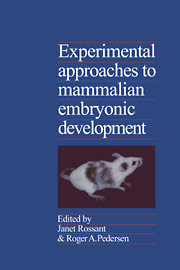Book contents
- Frontmatter
- Contents
- Preface
- Contributors
- Cellular aspects
- Molecular and biochemical aspects
- 6 Regulation of gene expression during mammalian spermatogenesis
- 7 Molecular aspects of mammalian oocyte growth and maturation
- 8 Utilization of genetic information in the preimplantation mouse embryo
- 9 Metabolic aspects of the physiology of the preimplantation embryo
- 10 Role of cell surface molecules in early mammalian development
- 11 Cell-lineage-specific gene expression in development
- 12 X-chromosome regulation in oogenesis and early mammalian development
- Toward a genetic understanding of development
- Index
8 - Utilization of genetic information in the preimplantation mouse embryo
from Molecular and biochemical aspects
Published online by Cambridge University Press: 31 March 2010
- Frontmatter
- Contents
- Preface
- Contributors
- Cellular aspects
- Molecular and biochemical aspects
- 6 Regulation of gene expression during mammalian spermatogenesis
- 7 Molecular aspects of mammalian oocyte growth and maturation
- 8 Utilization of genetic information in the preimplantation mouse embryo
- 9 Metabolic aspects of the physiology of the preimplantation embryo
- 10 Role of cell surface molecules in early mammalian development
- 11 Cell-lineage-specific gene expression in development
- 12 X-chromosome regulation in oogenesis and early mammalian development
- Toward a genetic understanding of development
- Index
Summary
Introduction
During the preimplantation period, the early zygote is transported from the ampullary end of the oviduct through the utero-tubal junction into the uterus. Over this period, the fertilized egg increases in cell number through several cleavage divisions and differentiates into the blastocyst, which contains two morphologically and biochemically distinct cell types, the inner cell mass (ICM) and trophectoderm. The length of time the embryo spends in the preimplantation period and the cell number achieved prior to implantation vary considerably from one mammalian species to another (see Chapter 3). Nonetheless, the formation of the blastocyst is a common feature of early development in all mammals. Most of the information regarding the molecular events underlying blastocyst formation derives from studies on embryos of the mouse and rabbit, although for early postfertilization and cleavage events, by far the bulk of the information comes from studies on mouse embryos. The subject also depends heavily on recent advances made in understanding the control of gene expression in eukaryotic cells in general. In this chapter, our discussion will largely be confined to eggs and early stages of mouse development. Particular emphasis is placed on the qualitative and quantitative changes that occur within mRNA populations in mouse embryos as they proceed in development from the first cleavage, which is largely under the control of informational macromolecules accumulated during oogenesis (see Chapter 7), to blastocyst formation, when there is active transcription and accumulation of new mRNA from the zygote genome. Information on posttranscriptional modification of mRNA through processing, capping, and polyadenylation is included. The protein synthesis changes that accompany changes in mRNA during this early developmental interval are also reviewed.
- Type
- Chapter
- Information
- Experimental Approaches to Mammalian Embryonic Development , pp. 239 - 266Publisher: Cambridge University PressPrint publication year: 1987
- 9
- Cited by



